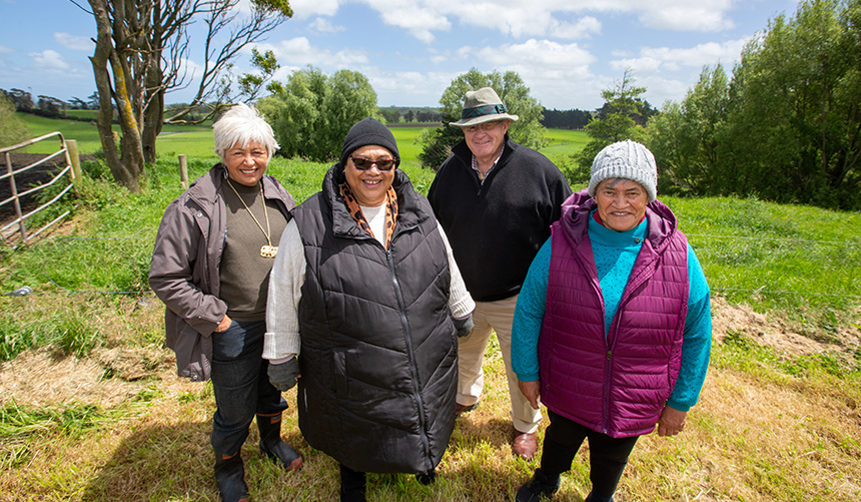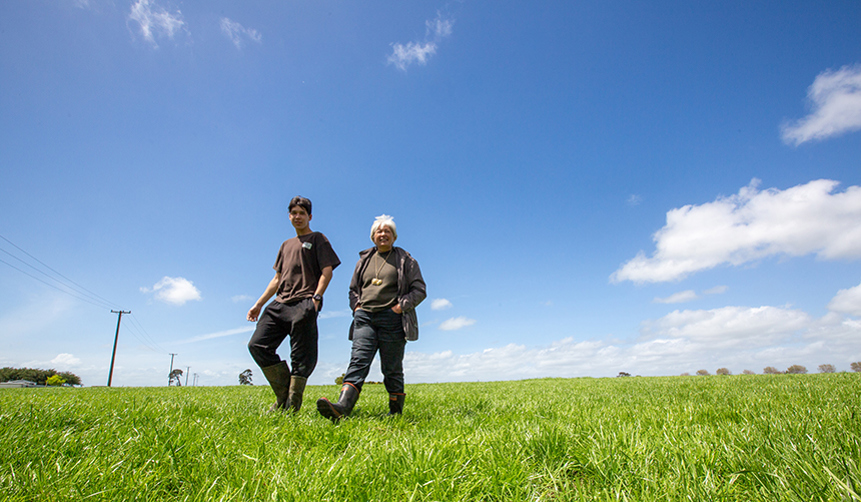What excellence looks like
Achieving success through kaitiakitanga
In 2009, 4 Taranaki ahu whenua trusts came together to form one large farm. 5 years later Te Rua O Te Moko Ltd. won the Ahuwhenua Trophy for excellence in dairy farming. A commitment to kaitiakitanga towards whānau and whenua steered the 4 trusts on their journey together.

In 2014 a Taranaki Trust, Te Rua O Te Moko Ltd, won the prestigious Ahuwhenua Trophy for excellence in dairy farming.
“That was massive for all the whānau,” says the chairman Dion Maaka. “We got a lot of owner involvement and that was part of the reason we won.”
It was an important marker of success at the end of the journey to combine four ahu whenua trusts into a 190 hectare joint venture dairy farm.
“We had three busloads of supporters of this whenua (at the Awards), and to see their faces when the farm was announced as a winner was just priceless.
“It truly showed the united front of a bunch of passionate owners who were rewarded for their courage and conviction in establishing this farm.”
Getting down to business
Combining their resources 10 years ago was the beginning of a new era for the 1,100 landowners. They went from leasing out their whenua to running an active enterprise where they were making the business decisions themselves.
Te Rua O Te Moko collectively milks 495 cows targeting production of 385kg milksolids per cow. They also run a training programme for young would-be farmers, and are at the forefront of a greenhouse gas emissions project.
Each ahu whenua trust holds shares on a pro-rata basis and elects a board to govern the affairs of the farm. This structure allows the land to be utilised while remaining in their ownership.
A bigger vision
Daisy Noble, who was the Ngāruahine negotiator for the iwi settlement, is a trustee of the block Te Rua O Te Moko 2B. At first, she was unsure of what a collective approach would mean for her whenua.
“It’s almost like handing on a part that you’ve been made responsible to look after and suddenly you have to look at ownership in a different way.
“Our block didn’t start off being totally supportive. But time and understanding of the wider context makes you more comfortable and you know you can create a bigger vision together.
“This is a start of whenua being returned the way it should have been – back to a hapū way of looking at land ownership,” says Daisy.
Joining the whenua
Te Rua O Te Moko collective is made up of 5 individual land blocks. 3 are under the governance of Te Tumu Paeroa, and 1 is governed by whānau under an ahu whenua trust. The fifth land block is leased from the Office of Treaty Settlements.
“One of the key things in the (Te Rua O Te Moko) journey is the acquisition of this particular land. It’s the last block that’s going to be available to us to bring back into the fold,” Daisy says.
The block has cultural significance. Daisy says it's where her hapū’s marae was situated before confiscation in the 1860s forced them to resettle on the other side of the Waingongoro River.
If Te Rua O Te Moko gets the opportunity to purchase the fifth block it will mean sacrificing owner dividends for a few years.

Taking on risk
Sharing financial risk is not a new challenge for the collective.
After the 4 ahu whenua blocks were pulled together, a new water system had to be installed. Paddocks were resized, re-grassed and fertilised. The next big expense was moving from 50/50 share milking to owning their own cows.
Judges of the Ahuwhenua Award praised the farm for its “good grasp of the financial aspects of the business” and “top end governance” through a diverse board and an independent director with strong expertise in the dairy industry.
Aiming for complete independence
The involvement of whānau is the most critical success factor as the venture moves towards complete autonomy.
“Te Tumu Paeroa certainly played a critical role with advisory, accounting and legal services in the beginning,” says Anne Marie Broughton, a former land development consultant with Te Tumu Paeroa who project managed the 2-year establishment phase.
“But I expect that over the next 10 years they can be exited from this venture.
“The next logical stage is for the landowners to have complete governance and management control of their lands. They will need to receive the right training and support because managing land with multiple owners is really complex and expensive.”
Looking to the future
The collective is preparing for that future.
Land Based Training equips uri and other young people with the skills to kick-start them into the industry. Every year each of the 8 fledgling farm staff find jobs or stay to help develop the farm.
“Our kaitiakitanga goes beyond managing our waterways and effluent,” says Dion Maaka. “It extends to our people.
“Looking through the owners’ lens, I would love for our people to be operating this farm, to be the next managers and governors. That’s really kaitiakitanga in its truest form for me.”